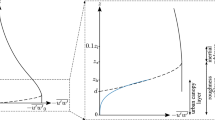Abstract
This paper traces the evolution of my “simple urban dispersion model”, beginning with the 1971 Atmospheric Turbulence and Diffusion Laboratory (ATDL) urban dispersion model, which was developed for application to urban area sources of radon. The Gaussian plume model is the basis, with use of Gifford’s novel derivation involving integration over upwind sources. The development continued with the addition of an urban meteorological preprocessor in the Hybrid Plume Dispersion Model (HPDM), accounting for the effects of strong mechanical mixing and increases in turbulence intensity in urban areas. Since 2000, the simple urban model was modified for US Department of Defense applications regarding toxic gas releases in built-up city centers, and tested with extensive field data. One model option is the Gaussian formula and another is an even simpler dimensionless relation.
Access this chapter
Tax calculation will be finalised at checkout
Purchases are for personal use only
Similar content being viewed by others
References
Briggs GA (1973) Diffusion estimation for small emissions. ATDL report no. 79, ATDL, NOAA/ARL, Oak Ridge
Britter RE, Hanna SR (2003) Flow and dispersion in urban areas. Annu Rev Fluid Mech 35:469–496
Gifford FA (1959) Computation of pollution from several sources. Int J Air Water Pollut 2:109–110
Gifford FA, Hanna SR (1973) Modeling urban air pollution. Atmos Environ 7:131–136
Hanna SR (1971) A simple method of calculating dispersion from urban area sources. J Air Pollut Control Assoc 21:774–777
Hanna SR, Baja E (2009) A simple urban dispersion model tested with field data from Oklahoma City and Manhattan. Atmos Environ 43:778–885
Hanna SR, Briggs GA, Hosker RP (1982) Handbook on atmospheric diffusion, DOE/TIC-11223 (DE82-002045). NTIS/USDOC, Springfield, 102 p
Hanna SR, Britter R, Franzese P (2003) A baseline urban dispersion model evaluated with Salt Lake City and Los Angeles tracer data. Atmos Environ 37:5069–5082
Hanna SR, Brown MJ, Camelli FE, Chan S, Coirier WJ, Hansen OR, Huber AH, Kim S, Reynolds RM (2006) Detailed simulations of atmospheric flow and dispersion in urban downtown areas by computational fluid dynamics (CFD) models – an application of five CFD models to Manhattan. Bull Am Meteorol Soc 87:1713–1726
Hanna SR, Chang JC (1992) Boundary layer parameterizations for applied dispersion modeling over urban areas. Bound-Lay Meteorol 58:229–259
Hanna SR, White J, Zhou Y (2007) Observed winds turbulence, and dispersion in built-up downtown areas in Oklahoma city and Manhattan. Bound-Lay Meteorol 125:441–468
Jensen SS, Larson T, Deepti KC, Kaufman JD (2009) Modeling traffic air pollution in street canyons in New York City for intra-urban exposure assessment in the US Multi-Ethnic Study of atherosclerosis and air pollution. Atmos Environ 43:4544–4556
McElroy JL, Pooler F (1968) The St. Louis dispersion study, vol II –Analysis. National Air Pollution Control Admin. Pub. No. AP-53. USDHEW, Arlington, 50 p
Neophytou MK, Britter R, Martin D, Price C, Nickless G, Shallcross D (2005) Results from a tracer field experiment in London (UK) and comparisons with predictions from urban dispersion models. In: Proceedings of the 5th international conference on urban air quality, Valencia, 29–31 Mar 2005
Venkatram A (2005) An examination of the urban dispersion curves derived from the St. Louis dispersion study. Atmos Environ 39:3813–3822
Author information
Authors and Affiliations
Corresponding author
Editor information
Editors and Affiliations
Rights and permissions
Copyright information
© 2014 Springer International Publishing Switzerland
About this paper
Cite this paper
Hanna, S. (2014). A 40-Year History of a Simple Urban Dispersion Model and Its Evaluation. In: Steyn, D., Mathur, R. (eds) Air Pollution Modeling and its Application XXIII. Springer Proceedings in Complexity. Springer, Cham. https://doi.org/10.1007/978-3-319-04379-1_54
Download citation
DOI: https://doi.org/10.1007/978-3-319-04379-1_54
Published:
Publisher Name: Springer, Cham
Print ISBN: 978-3-319-04378-4
Online ISBN: 978-3-319-04379-1
eBook Packages: Earth and Environmental ScienceEarth and Environmental Science (R0)



